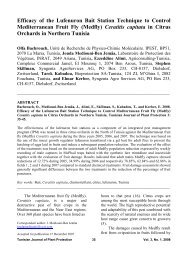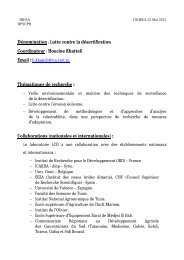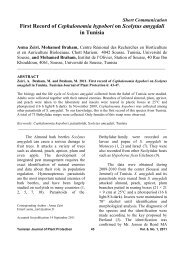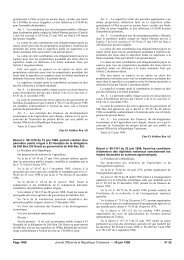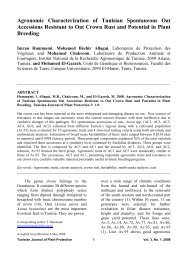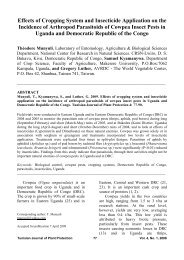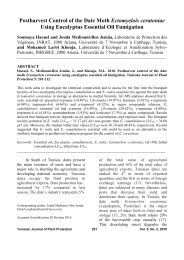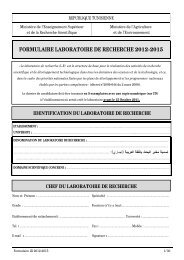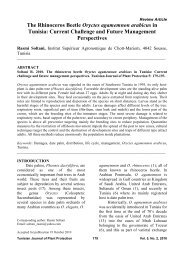You also want an ePaper? Increase the reach of your titles
YUMPU automatically turns print PDFs into web optimized ePapers that Google loves.
Laboratory Rearing of Immature Stages of <strong>Oryctes</strong><strong>agamemnon</strong> <strong>arabicus</strong> under Three Constant TemperaturesRasmi Soltani, Centre Régional de Recherches Agricoles de Sidi Bouzid, 9100 SidiBouzid, Université de Kairouan, Tunisie__________________________________________________________________________ABSTRACTSoltani, R. 2012. Laboratory rearing of immature stages of <strong>Oryctes</strong> <strong>agamemnon</strong> <strong>arabicus</strong> underthree constant temperatures. Tunisian Journal of Plant Protection 7: 35-42.<strong>Oryctes</strong> <strong>agamemnon</strong> <strong>arabicus</strong> was a new exotic species signalled in the oasis of southwest Tunisiasince 1995 where it was specifically associated to date palm. Few bibliographies on the biology of thespecies exist in the world. Thus, the aim of this work is to study the development of immature stages ofthis pest under laboratory conditions at three temperatures 23, 27 and 30°C. Results concerning thedevelopment of immature stages showed that means duration of the incubation period, the total larvaldevelopment and pupa were 14.16 ± 1.69, 227.62 ± 15.79, and 24.29 ± 2.75 days at 23°C, 11.84 ± 1.3,199.2 ± 12.32, and 22.27 ± 1.92 days at 27°C, and 9.49 ± 1.17, 222.39 ± 10.43, and 21.16 ± 1.85 daysat 30°C, respectively. These facts indicated that O. <strong>agamemnon</strong> <strong>arabicus</strong> accomplished its totalimmature stage development in 266.18 ± 15.96 days at 23°C, 229.93 ± 10.35 days at 27°C, and 253.03± 10.94 days at 30°C.Keywords: Date palm, life cycle, <strong>Oryctes</strong> <strong>agamemnon</strong> <strong>arabicus</strong>, rearing, temperature.__________________________________________________________________________Date palm, Phoenix dactylifera, isa strategic crop of economic importancein Tunisia. It is widely grownsuccessfully in the south of the country;its cultivated area occupies about 40,000ha with around 6 million trees (2).Locally, wide range of insect species areable to attack date palm trees causing asignificant and serious yield losses; themost harmful are the carob mothEctomyelois ceratoniae, the white scaleParlatoria blanchardi, Apate monachus,the acarina called Boufaroua Oligonychusafrasiaticus and others (2).Corresponding Author: Rasmi SoltaniEmail: rasmi.soltani@iresa.agrinet.tnAccepted for publication 14 March 2012The rhinoceros beetle <strong>Oryctes</strong><strong>agamemnon</strong> <strong>arabicus</strong> (Coleoptera,Scarabaeidae) is signaled as a secondarypest within orchards of date palm trees inmost Gulf countries as Kingdom of SaudiArabia (18), Irak, United Arab Emirates(12), Sultanate of Oman (1) and lately inTunisia (9). This pest had been officiallysignaled in Tunisia for the first time in1995 after the sudden collapse of manyproductive palm trees in Mrah Lahouaroasis from Tozeur governorate (9, 13,14). Inside oasis, it was considered as amonophagous pest attacking only datepalm tree with its different varieties. Afterthis date, the pest was reported in severalother locations of the Djerid and on theoases of Rjim Maatoug belonging toKebili governorate. Until 2006, the pestinvaded about 3,310 ha of date palm treeslocated in Djerid zone and in the extremewest of Kebili (15).Tunisian Journal of Plant Protection 35 Vol. 7, No. 1, 2012
Development of immature stagesoccurred inside hidden and well protectedbreeding sites of the palm tree making itsmanagement difficult. These breedingsites are located almost on different partof the palm tree mainly on respiratoryroots and external components of thestem (matrixes of fibrilium, stem bark andinside the basal part of dry petiole) andthe four oldest levels of green palmssituated at the base of the crown. Afterseveral years of repeated attacks,specifically on respiratory roots part, thispest can causes significant damage thatresult in the collapse of the plant asalready observed in Mrah Lahouar andRjim Maatoug (15, 16).Little data are available on O.<strong>agamemnon</strong> <strong>arabicus</strong> both in Tunisia andworldwide. In order to develop bettertechniques for its monitoring andmanagement strategies, understanding thelife history of this pest can constitute afirst basically step and a mainly key todevelop such techniques. Thus, thepresent work aimed to study the durationof developmental period of immaturestages of this pest under three controlledtemperatures conditions.MATERIALS AND METHODSBiological material. Adults of O.<strong>agamemnon</strong> <strong>arabicus</strong> used in this studywere originally collected from infestedarea of Rjim Maatoug in Kebiligovernorate, located on the southwest ofTunisia during the end of summer 2006.A number of sixteen couples were used inthis survey. Females used in this studystarted already their oviposition activityin the field. After their catch, they werealso confined with male insiderectangular plastic boxes (15 × 20 × 10cm). These boxes were filled with a thicklayer of 3-5 cm of friable material,collected from natural breeding siteswithin oases, in the goal to create amiddle like inside infested parts of palmtrees where couples burrowed to copulate.It is also important to mention that coupleformation, copulation, and ovipositionactivity occurred inside obscure parts ofthe plant.Breeding and experimentalprotocol. Breeding medium used in allassays of this work was originally chosenby Soltani et al. (17) to breed the samespecies under laboratory conditions. Thissubstrate is of natural origin, collecteddirectly from the living sites of thespecies in date palm trees. It consists offine wood granules, which are the bits offood discarded on both sides of themouthparts of larvae during their diets onthe wood of hairy respiratory roots or ondry petiole and fibrilum matrixes, of lessthan 3 mm in size.Initial relative humidity measuredfor initially collected substrate dependson the existing developmental stage. Infact, from oviposition sites, it varies from26 to 34% while for the larvae sites thismoisture ranges between 38 to 65%.This substrate was mainly used forfemales which burrowed themselvesinside to lay eggs on. The first part of thestudy which interested couples wascarried under ambient temperature of thelaboratory. Boxes were daily controlledtwice (in the morning and in theafternoon); during these operationscontent of each box was sieved separatelyto collect fresh eggs laid inside thesubstrate. Then, substrate was returnedinside box with female to continue itsoviposition activity.Eggs collected in the same time,never directly handled, were transferredtogether, by group of 10 maximum, tosmall rectangular opaque plastic boxes (5× 10 × 5 cm) used as incubator andcontaining a 3 cm thick layer of the samefriable material used for oviposition. EggsTunisian Journal of Plant Protection 36 Vol. 7, No. 1, 2012
were two third burrowed on the surface ofsubstrate to facilitate developmentalsurvey; then boxes were moved undercontrolled conditions. Experiences wereinitially established using 70, 100 and 60eggs in the same previous order oftemperature. Holes were made in thecover of each box to decrease thehumidity inside.Larval development occurredthrough three stages which differentiationoccurred based on the dimensions ofcephalic capsules and the body size asalready determined by Soltani et al. (17).They were reared by group of three larvaeinside opaque plastic boxes (15 × 20 × 10cm) on the same food substrate usedpreviously. Boxes were filled with a thicklayer of substrate of 5-7 cm. Larvaereared inside the same box are of thesame age i.e., they hatched or molt in thesame day.Rearing of O. <strong>agamemnon</strong><strong>arabicus</strong> occurred in the laboratory withinthree different obscure climate chambersand at three constant temperatures: 23 ±1°C, 27 ± 1°C and 30 ± 1°C. Humiditydepended on the breeding stage; in fact,incubation took place under a mean ofrelative humidity of 30 ± 4%. However,all larval development and pupaeoccurred under an average of relativehumidity of 50 ± 8%. Photoperiod, whichmainly interest larvae, was nil becausethey are blind without eyes.Biological parameters. Pestdevelopment was daily examined untiladult emergence. The followingparameters were surveyed:- The incubation time: timeelapsed between egg laying and egghatching.- The larval development: larvaldevelopment completed through threedistinct stages including pre-pupa(including the third stage). The durationof each one of them was measured.During experiments, specimens that diedwere discarded but the duration of eachbiological stage completed before deathwas used in the calculation of means.Each one of the three larval stages wasstudied separately, then the total durationof the larval development was estimated.- Pupa: time elapsed between thirdlarval molting and adult emergence.Once development of theseinstars achieved, the developmentalperiod of immature instars wasdetermined for each temperature.Statistical analyses. Collecteddata were subject to statistical analysesusing the SPSS software for windows(version 16). Analyses of variance(ANOVA) applied to each stagepermitted testing the effect oftemperatures on the period of incubation,larval development and pupae. Meanswere compared and separated into subsetsusing the LSD test at 5% level.RESULTSImmature stage development.The mean duration of development ofimmature stages (measured in days) atvarious constant temperatures withstandard deviation are given in Table 1.Incubation. The incubationperiod, as illustrated in Table 1,constituted the shortest stage ofdevelopment of the pest. In fact, eggswere hatched in 14.16 ± 1.69, 11.84 ± 1.3and 9.49 ± 1.17 days at 23, 27 and 30°C,respectively. Analysis of variance showedsignificant differences betweenincubation periods under the testedtemperatures. The LSD-test allowed theclassification of means into threehomogeneous subsets represented by theletter (a, b, and c) inside Table 1.Tunisian Journal of Plant Protection 37 Vol. 7, No. 1, 2012
Table 1. Developmental time of immature stages of <strong>Oryctes</strong> <strong>agamemnon</strong><strong>arabicus</strong> reared in laboratory at three constant temperatures regimesDays required (mean ± SD) to complete each life stage23°C 27°C 30°CInitial eggs N i = 70 N i = 100 N i = 60Incubation14.16 ± 1.69 a 11.84 ± 1.3 b 9.49 ± 1.17 cn = 61n = 87N = 53L 135.42 ± 3.23 a 34.85 ± 3.13 a 35.78 ± 2.27 an = 48N = 78N = 45Larval 50.82 ± 4.87 a 43.66 ± 3.88 b 45.19 ± 3.14 cLstages 2N = 38N = 74N = 42L 3140.85 ± 15.23 a 118.22 ± 10.05 b 141.84 ± 11.78 aN = 34N = 69N = 39Pupa24.29 ± 2.75a 22.27 ± 1.92 b 21.16 ± 1.85 cN = 34N = 55n = 38Means in the same line followed by the same letter (a, b or c) are notsignificantly different according to the LSD test (at P ≤ 0.05,); N i : Initialnumber.The infertile eggs are recognizablefour days after oviposition by their colorturning on brownish and their aspectbecoming dry and shriveled. However,alive eggs changed their volumeprogressively and their color initiallywhite tends to transparence whenhatching approached. The registeredhatching rates were 87.14% at 23°C, 87%at 27°C and 88.33% at 30°C. Theseresults showed a high rate of fertilityunder these different temperatures.Larval development. The meanduration of the first and the second larvalstages were illustrated in Table 1.Statistical analysis using the one-wayANOVA reveal the presence of asignificant differences for the secondlarval stage only; the relative means wereclassified in three distinct subsets basedon the LSD-test (Table 1).The third larval stage completedits development in 140.85 ± 15.23, 199.2± 12.32 and 141.84 ± 11.78 days at 23°C,27°C and 30°C, respectively. Analysis ofvariance showed significant differencesbetween these periods (Table 1). The useof LSD-test permitted the classification oftemperature means into two subsets asfollows: 23°C/30°C and 27°C.The larval period relative to eachtemperature varied between minimumand maximum of 193-274, 173-228 and201-245 days at 23, 27 and 30°C,respectively, with respective means of227.62 ± 15.79, 199.2 ± 12.32 and 222.39± 10.43 days (Figure 1). Statisticalanalysis revealed the existence of asignificant difference between theseperiods of development under thedifferent temperatures; means wereseparated into two subsets i.e. 23°C/30°Cand 27°C.Advanced interpretation of theseresults revealed that the third larval stagedominates both the larval developmentand the total development of immaturestages. In fact, it represented 61.88%,59.35% and 63.78% of larvaldevelopment and 52.92%, 51.42% and56.06% of immature stages duration at23°C, 27°C and 30°C, respectively.Before achieving the pre-pupaestage, larvae migrate deeply inside thesubstrate and reduce progressively theirfeeding activity. Their migration wasstopped by the basal and lateral innersides of the box, which is hard anddifficult to perforate, stimulating, thus,the entry to pre-pupal stage. In fact, eachlarva kept its position inside the roomTunisian Journal of Plant Protection 38 Vol. 7, No. 1, 2012
situated at the extremity of its feedingtunnel, repels the substrate using its legsand compresses it using its abdominalextremity; by this way, walls of the roombecame more cemented and compact. Thevolume of the room was estimated to fourtimes the volume of the larva. At the end,larva gains a dorsal position; the legssuspended in the air and initiate the prepupalperiod.Pre-pupa. Pre-pupa constitute anintermediate pseudo-stage between thelarval life and pupa. In fact, larvae whichgain a dorsal position become sluggishwrinkled with suspended feeding andmovement (legs in air). The duration ofthis pseudo-stage was not noticed inTable 1; it was merged with the durationof third stage. However, it lasted onaverage 17.91 ± 2.45 days at 23°C, 15.86± 2.86 days at 27°C and 15.84 ± 2.72days at 30°C.Pupa. Pupa took minimum andmaximum period of 19-29, 18-27 and 17-25 days at 23°C, 27°C and 30°C,respectively. The use of ANOVA-testreveals a significant difference betweenthe registered periods which were dividedinto three subsets based on the LSD test(Table 1).The total mean durations ofimmature stages relative to eachtemperature were illustrated in Figure 1with larval development. It shows a totaldomination of larval development ascompared to the other stages (Table 1);the relative percentage of this durationranged between 85.51% and 87.89%under these temperatures. Analysis ofvariance showed a significant differencebetween these periods (Figure 1).Duration (days)300250200150100abaabc23°C27°C30°C500Larval DevelopmentComplete CycleFig. 1. Duration of the larval development and the complete cycle of immature stages of <strong>Oryctes</strong> <strong>agamemnon</strong><strong>arabicus</strong> recorded under three constant temperatures (Means of the same group followed by the same letter (a, bor c) are not significantly different according to the LSD test (at P ≤ 0.05)).Tunisian Journal of Plant Protection 39 Vol. 7, No. 1, 2012
As shown in Figure 1, theimmature stage developmental durationvaries depending on temperatures tested.Significant differences were observed intotal life cycle of immature stages of O.<strong>agamemnon</strong> <strong>arabicus</strong> developed underthe three constant temperatures. In fact,the duration was longer when the insectwas reared at 23°C and 30°C incomparison with 27°C. Means durationswere 266.18 ± 15.96, 229.93 ± 10.35, and253.03 ± 10.94 days at 23°C, 27°C and30°C, respectively. This result wasconfirmed by the LSD-test which allowedthe classification of temperature means inthree homogeneous subsets (Figure 1).Table 1 also shows that incubation period,the second and third larval stages andpupa contributed significantly to thisdifference.DISCUSSIONAs shown in above presentedresults, the immature stagesdevelopmental time varies greatlydepending on temperatures. In fact, theoptimum temperature for breeding,permitting the lowest duration ofdevelopment, is situated at 27°C. It wasclear that the immature stages andparticularly the larval developmentdominates the life cycle of this pest.Generally, this cycle is similar to that ofother species belonging to the same genuscharacterized, as shown in Table 2, by thedominance of larval developmental timeas compared to the duration of the totalcycle.In the present study, it is importantto mention that the total life cycle of thispest was completed in less than 8 monthsat 27°C and less than 9 months both at23°C and 30°C. Thus, O. <strong>agamemnon</strong><strong>arabicus</strong> could produce threegenerations/two years. In comparison tothe bibliography, it is mentioned that thedevelopmental cycle within <strong>Oryctes</strong>genus was well diversified (Table 2).However, some species have less thanone year life cycle as reported for O.rhinoceros (11, 18) while others have oneyear life cycle as is the case of O. elegans(11) and O. <strong>agamemnon</strong> (10). Thedevelopment of O. nasicornis occurseither on one year in Ivory Coast or ontwo to three years in Ukraine (3). Lifecycle duration in this case was dependanton existing conditions.Obtained results at 23°C weresimilar to those reported by Soltani et al.(17) under 23°C and a RH of 55 ± 6 %which advanced a mean developmentaltime of 274 days for O. <strong>agamemnon</strong> onthe same substrate.Table 2. Developmental time of three species of the genus <strong>Oryctes</strong>Time required in daysSpecies EggsLarval development Pupa ReferencesL 1 L 2 L 310-O.16115-175 20-28 (10)<strong>agamemnon</strong> 11- 31- 51-16 38 6898-162 20-29 (13, 17)11 21 21 35-63 21 (8)O.10- 12-8-12rhinoceros21 2160-165 17-28 (4, 5, 19)12 72-130 20 (6)O. elegans 2-8 270-300 21 (11)Tunisian Journal of Plant Protection 40 Vol. 7, No. 1, 2012
Concerning O. <strong>agamemnon</strong><strong>arabicus</strong> collected from Tunisia, larvaerepresented the harmful stage of the pestwithin date palm oases (13, 14, 16).Consequently, the knowledge of suchbiological information will constitute inthe future a base to start a managementprogram against this pest.In conclusion, the present workfocused on the immature stages of O.<strong>agamemnon</strong> <strong>arabicus</strong> obtained undercontrolled laboratory conditionsconstitute a basic step in furtherunderstanding the species. In fact, itconfirmed in one hand the mastery ofbreeding techniques and on the otherhand provided important and fundamentalinformation on its developmental andimmature stages cycle under threeconstant temperatures. By this way, itbecame possible to start managementexperiments on this pest under laboratoryconditions before being applied in theoases ecosystem.__________________________________________________________________________RESUMESoltani R. 2012. Elevage au laboratoire du scarabé rhinocéros <strong>Oryctes</strong> <strong>agamemnon</strong> <strong>arabicus</strong> sousles conditions de trois températures constantes. Tunisian Journal of Plant Protection 7: 35-42.<strong>Oryctes</strong> <strong>agamemnon</strong> <strong>arabicus</strong> est une espèce exotique qui a été signalée pour la première fois dans lesoasis du sud ouest de la Tunisie en 1995 et où elle se trouve inféodée au palmier dattier. Peu debibliographies sur la biologie de l’espèce existent à travers le monde. D’où, l’objectif de ce travail estd’étudier le développement des stades immatures de l’espèce sous les conditions du laboratoire et àtrois températures constantes 23, 27 et 30°C. Les résultats concernant le développement des stadesimmatures montrent que les durées moyennes obtenues pour la période d’incubation, le développementlarvaire complet et la nymphose sont de 14.16 ± 1.69, 227.62 ± 15.79 et 24.29 ± 2.75 jours à 23°C, de11.84 ± 1.3, 199.2 ± 12.32 et 22.27 ± 1.92 jours à 27°C et de 9.49 ± 1.17, 222.39 ± 10.43 et 21.16 ±1.85 jours à 30°C. Ces résultats indiquent qu’O. <strong>agamemnon</strong> <strong>arabicus</strong> accomplit son cycle dedéveloppement jusqu’à l’émergence du stade imago en une durée moyenne de 266.18 ± 15.96 jours à23°C, 229.93 ± 10.35 jours à 27°C et 253.03 ± 10.94 jours à 30°C.Mots clés: Cycle de vie, élevage, <strong>Oryctes</strong> <strong>agamemnon</strong> <strong>arabicus</strong>, palmier dattier, température__________________________________________________________________________،<strong>Oryctes</strong> <strong>agamemnon</strong> <strong>arabicus</strong>Tunisian Journal of Plant Protection 7: 35-42..2012ملخصسلطاني، رسمي.درجات حرارة ثابتة.التربية المخبرية لخنفساء وحيدة القرنتحت ثلاثس°نوعاً دخيلاً أشير إلى وجوده في واحات الجنوبآانت خنفساء وحيدة القرنحيث ارتبط وجودها بشكل خاص بنخيل التمر. وتعد المراجع العلمية المهتمة بشأنالغربي التونسي منذ سنة بيولوجية هذا النوع نادرة الوجود في العالم. لذا، فإن الهدف من هذا العمل هو دراسة تطور المراحل غير البالغة لهذه الآفةبينت النتائج أن معدل فترة الحضانةو و درجات من الحرارة: تحت الظروف المخبرية عند ثلاث يوماوووالتطور الشامل لليرقات والعذارى آانت على التواليوويوما عند وووفي وتشير النتائج أيضا إلى أن فترة تطور الأطوار غير البالغة للخنفساء تدوميوما عند ويوما عندويوما عند يوما عند 23في30 س° .2.75 ± 24.29 15.79 ± 227.6227 س° ± 222.39 1.17 ± 9.4927 س° 10.94 ± 253.03<strong>Oryctes</strong> <strong>agamemnon</strong> <strong>arabicus</strong>1995س°س°س°27 231.69 ± 14.161.92 ± 22.27 12.32 ± 199.2 3.1 ± 11.84 23. 30 1.85 ± 21.16 10.43و 10.35 ± 229.93المعدل ± 266.18 15.96. 30نخيل التمر، <strong>Oryctes</strong> <strong>agamemnon</strong> <strong>arabicus</strong>__________________________________________________________________________آلمات مفتاحية: تربية مخبرية، درجة حرارة ثابتة ، دورة حياة،Tunisian Journal of Plant Protection 41 Vol. 7, No. 1, 2012
LITERATURE CITED1. Al-Sayed, A.E. and Al-Tamiemi, S.S. 1999.Seasonal activity of the fruit stalk-borer,<strong>Oryctes</strong> <strong>agamemnon</strong> (Burm.) (Coleoptera-Scarabaeidae) in Sultanate of Oman. Egypt. J.Agri. Res. 77: 1597-1605.2. Anonyme, 2010. C.R.D.A Tozeur, 2010. Rapportd’activités.3. Balachowsky, A.S. 1962. Entomologie appliquéeà l’agriculture. Tome I. Coléoptères. PremierVolume. Caraboidea- Staphylinoidea-Hydrophiloidea- Scarabaeoidea- Dascilloidea-Cantharoidea- Bostrychoidea- Cucujoidea-Phytophagoidea (Cerambycidae et Bruchidae).Masson et C ie Editeurs, France, 465 pp.4. Bedford, G.O. 1976. Observations on the biologyand ecology of <strong>Oryctes</strong> rhinoceros andScapanes australis (Coleoptera: Scarabaeidae:Dynastinae): pests. J. Aust. Entomol. Soc. 15:241-251.5. Bedford, G.O. 1980. Biology, ecology and controlof palm rhinoceros beetles. Ann. Rev. Entomol.25: 309-339.6. Giblin-Davis, R.M. 2001. Borers of palms. Pages267-304. In: Insects on Palms. F.W. Howard, D.Moore, R. M. Giblin-Davis and R.G. Abad,CABI Publishing. Willington, UK, 400 pp.7. Hammes, C. and Monsarrat, P. 1974. Recherchessur <strong>Oryctes</strong> rhinoceros L. Source CahiersORSTOM. Série Biologie 22: 43-91.8. Hinckley, A.D. 1973. Ecology of the coconutrhinoceros beetle, <strong>Oryctes</strong> rhinoceros (L.)(Coleoptera: Dynastidae). Biotropica 5: 111-116.9. Khoualdia, O. and Rhouma, A. 1997. Premièresobservations sur <strong>Oryctes</strong> <strong>agamemnon</strong>, ravageurdu palmier dattier en Tunisie. Fruits 52: 111-115.10. Lepesme, P. 1947. Les insectes des palmiers.Paul Lechevalier Editions, France, 799 pp.11. Lokma, H.I.E. 2000. Borers of palm treesconference. Ministry of Agriculture & Waterconference, KSA, 14 pp.12. Med Saeed, G. 2004. Pests of the date palm(Phoenix dactylifera). Available online at:http://www.icarda.org/APRP/Datepalm/Topics/Pest/Pestright.htm13. Soltani, R. 2004. <strong>Oryctes</strong> <strong>agamemnon</strong>Burmeister (Coleoptera: Scarabaeidae):Contribution à l’étude de sa biologie et desdégâts occasionnés dans les oasis du Djérid auSud Ouest Tunisien. Diplôme d’EtudesApprofondies, Ecole Supérieure d’Horticultureet d’Elevage de Chott-Marien, Université deSousse, Tunisie, 81 pp.14. Soltani, R. 2009. <strong>Oryctes</strong> <strong>agamemnon</strong> <strong>arabicus</strong>Fairmaire, 1896: Etude bioécologique etéthologique dans les oasis de Rjim Maâtoug ausud ouest Tunisien. Thèse de Doctorat, InstitutSupérieur Agronomique de Chott-Mariem,Université de Sousse, Tunisie, 152 pp.15. Soltani R., 2010. The rhinoceros beetle <strong>Oryctes</strong><strong>agamemnon</strong> <strong>arabicus</strong> in Tunisia: Currentchallenge and future management perspectives.Tunisian J. Plant Prot. 5: 179-19316. Soltani, R., Chaieb, I., and Ben Hamouda, M.H.2008. Descriptive study of damage caused bythe rhinoceros beetle, <strong>Oryctes</strong> <strong>agamemnon</strong>, andits influence on date palm oases of RjimMaatoug, Tunisia. J. Insect Sci. 8: 57.17. Soltani, R., Chaieb I., and Ben Hamouda, M.H.2008. Life cycle of the root borer, <strong>Oryctes</strong><strong>agamemnon</strong>, under laboratory conditions. J.Insect Sci. 8: 68.18. Talhouk, A.S. 1982. The present status of datepalm pests in Saudi Arabia. Pages 432-437. In:Proceedings of the first symposium on the datepalm held at King Fiasal University. March 23-25, 1982, Al-Hassa, KSA.19. Waterhouse, D.F. and Norris, K.R. 1987.<strong>Oryctes</strong> rhinoceros (Linnaeus). Pages 101-117.In: Biological control: Pacific Prospects. D.F.Waterhouse and K.R. Norris. ACIAR,Melbourne: Inkata Press, Australia.--------------------Tunisian Journal of Plant Protection 42 Vol. 7, No. 1, 2012






